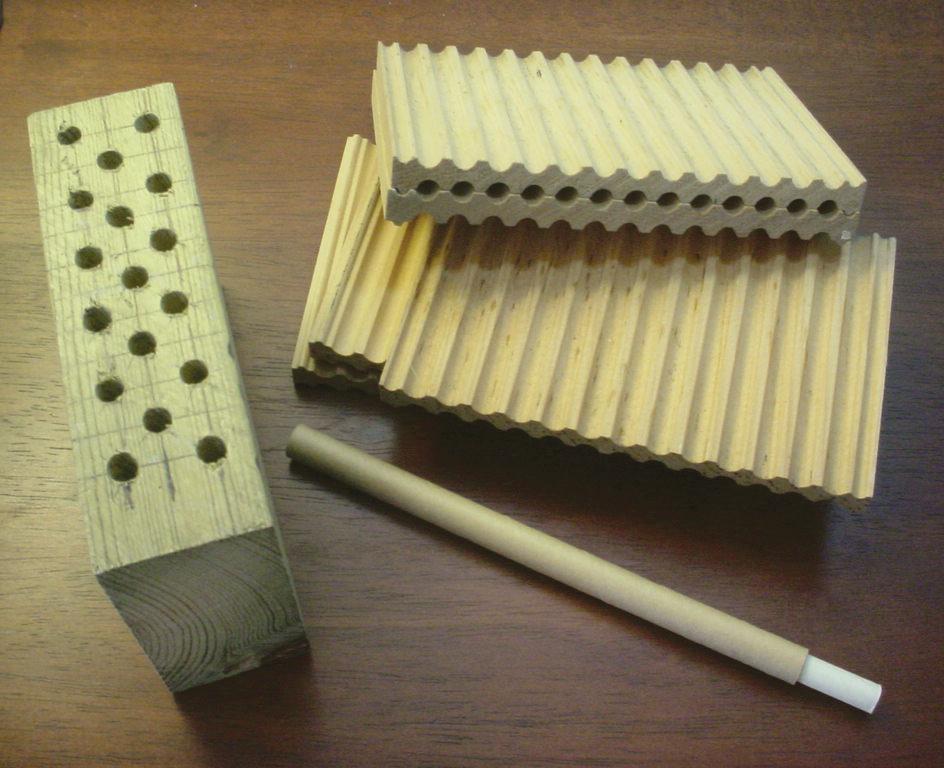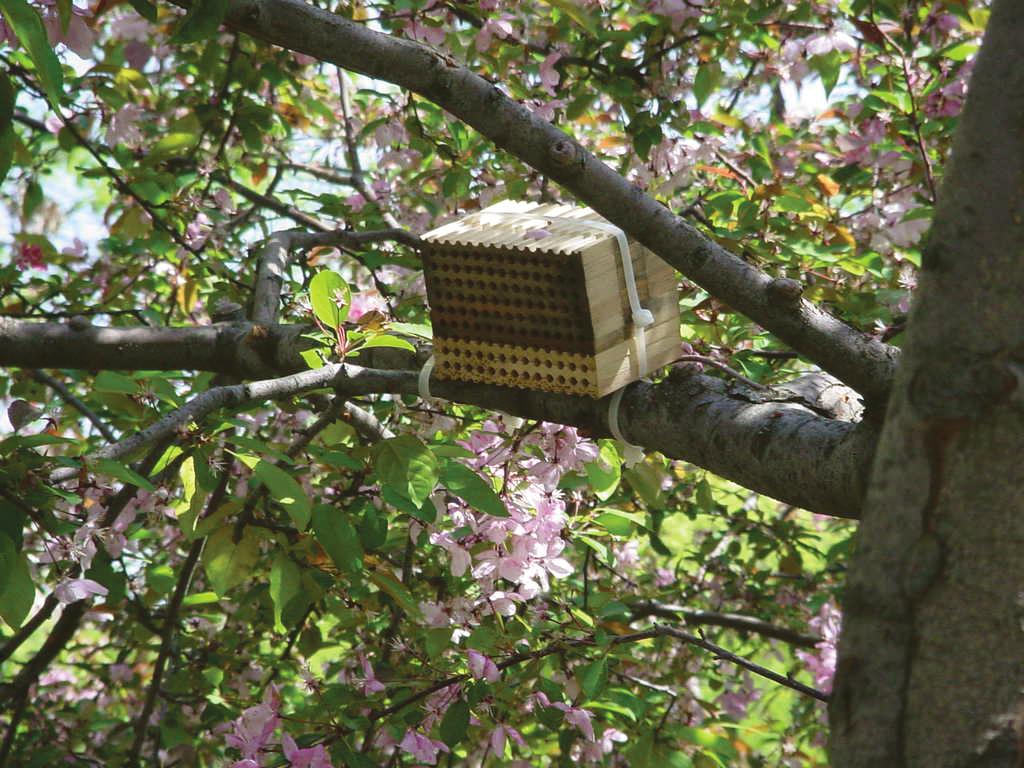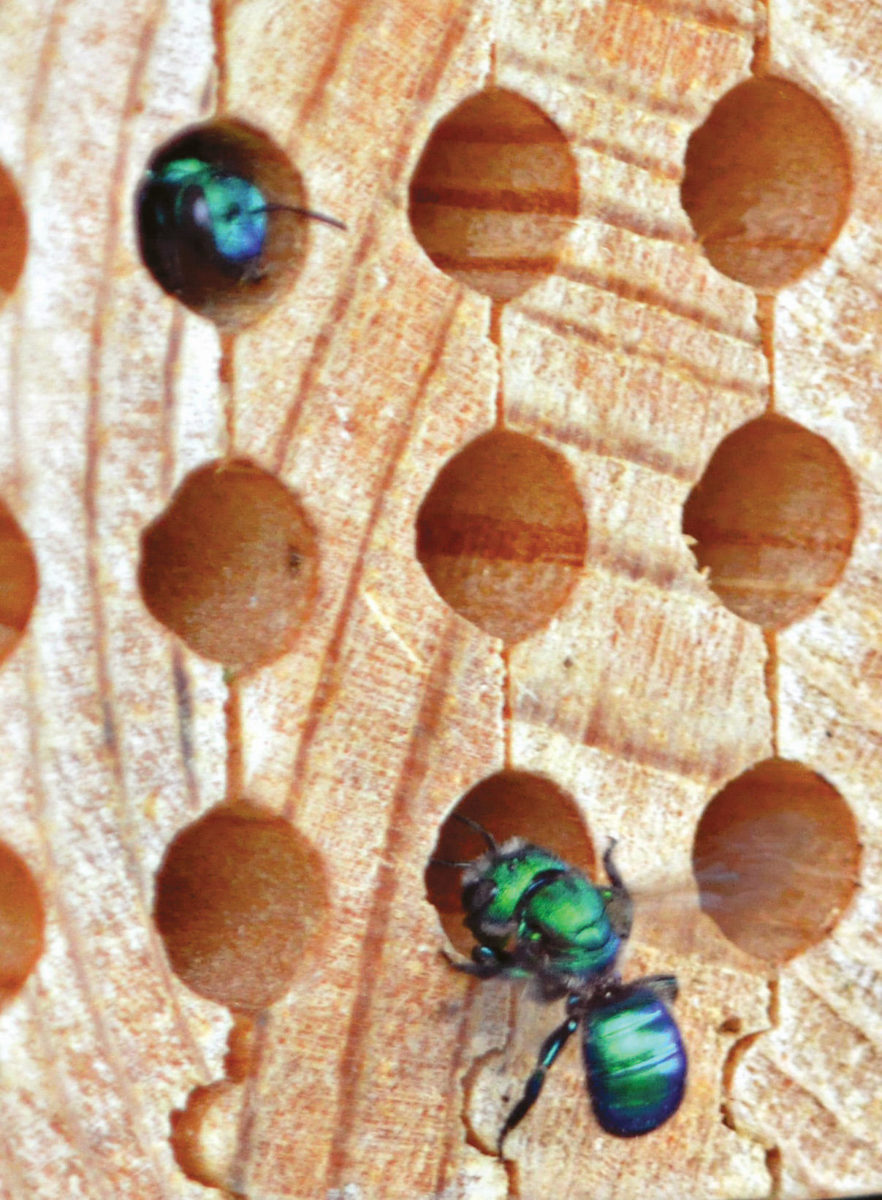
Common materials used as mason bee nests include drilled wooden blocks, reed or bamboo sections, cardboard tubes, and grooved boards (Figure 6.15). Historically, the earliest mason bee nests in the US were similar to nest designs for the alfalfa leafcutter bee—consisting of drilled pine or fir boards, usually 6-inch x 6-inch boards up to 4 feet (~15 x 15 centimeters and up to ~1.2 meters) in length. To reduce weathering and water damage, the outer surfaces of these nests are usually treated with polyurethane varnish. Treatment of the inner cavities is not necessary and may actually repel bees.
These solid nest blocks are drilled with a series of dead-end holes for nest tunnels. Nest blocks of this type are commercially available, and are fairly attractive to bees. With these nests, dormant bees are left to overwinter inside the block. The block is either left outside or placed in cold storage.
Because the inner nest surfaces of nest blocks cannot be exposed for cleaning, they tend to become contaminated over time with diseases, such as the fungal pathogen chalkbrood (Ascosphaera torchioi), or parasites such as the hairy-fingered mites (Chaetodactylus krombeini) over time. See Appendix A, for more information. Nests in continuous use for several seasons tend to be the most contaminated.
In order to remove bees from these nests for cleaning, a phase-out system must be employed. Phase-out systems prevent emerging bees from returning to old nests, thus allowing old nests to be disinfected before reuse. Typically a phase-out system will include an opaque container or some kind of dark emergence box attached to the field shelter. This opaque container should have a small opening through which light can enter. As bees emerge from the nest tunnel, they are attracted to the light and exit into the shelter, which should be furnished with clean, previously unused nests. Then, after all bees have emerged, the old nest blocks can be removed for cleaning. In this way, old nest materials are phased out on an annual basis. Once the nest blocks are empty, they are disinfected by submerging in a bleach-water solution (1:3) for one minute, and then allowed to dry.
An alternative to phase-out systems is the use of paper straw tunnel liners. Such straws are inserted into the nest holes, and then removed several months after the nesting period. The tubes containing dormant bees are then typically placed in a parasite-free storage area for the winter. The nest blocks are cleaned using the 1:3 bleach-water treatment.
If paper tube liners are used in solid blocks, the inserted end should be closed off with wax, hot glue, or something similar to avoid the innermost cocoon becoming attached to the inner wall when the straw is removed. Similarly, straw liners should fit snuggly within the cavity to prevent parasitic wasps from entering any vacant spaces between straws and inner walls.
Finally, some solid block nests are drilled all the way through and sealed on one side with some type of backing material such as foil-type duct tape. With this backing removed, nests can be more thoroughly cleaned and inspected before they are reused. The problem with these nests is that, unless the backing material is extremely tight fitting, parasites and nest destroyers such as earwigs can easily move between tunnels. Also, if adhesive-type backings, such as foil duct tape are used, the cavities must be dusted with sand to cover the exposed sticky surface, and to reduce light reflection (which may repel nesting females). Another option for backing material is a sheet of closed-cell foam held in place by a rigid board. See Appendix E, for an example.

Aggressive sanitation, annual nest phase-out, the use of paper straws, and removable backing materials will minimize parasite and disease issues, but is unlikely to completely eliminate them. To maintain bee health, nest blocks should be periodically discarded and replaced with new ones.
Grooved boards (also called laminates) are a stackable nesting system consisting of individual boards routed with a series of channels (Figure 6.16). When the boards are clamped together, the channels form a series of tunnels similar to a solid nest block. The advantage of laminates is that they are easily disassembled, allowing for thorough cleaning and inspection. However, crevices between boards may allow light to enter, making the nests less attractive to bees. And they also may provide additional access points for parasites. As with solid block nests, paper straw liners can be used with laminated boards. Grooved boards should also be phased out regularly and cleaned following the guidelines for solid block nests (Figure 6.17).

Cardboard tubes are another popular nesting option, often used in conjunction with removable paper straw inserts and plastic stoppers. Tubes are cheap and readily available from many manufacturers. When bundled together, cardboard tubes of the same length present a solid surface of nest tunnels. To provide visual landmarks for returning foragers, they should be painted in varying colors. Nesting females entering the wrong nest cavities result in skirmishes, and the spread of parasites and disease. Cardboard tubes also provide less protection against moisture and predators, and are less attractive to bees than wood surfaces. If cardboard tubes are used, walls should be at least 1 millimeter thick to reduce egg laying by parasitic wasps such as Monodontomerus (see Appendix A). As with solid block and grooved board nests, cardboard tubes should be phased out regularly to prevent re-nesting in previously used cavities.
Finally, cut sections of reed or bamboo may be used as nests. These materials are normally cut in a way that uses the natural node as a tunnel backing—creating either single tubes, or two tubes facing opposite directions separated by a central node. These materials provide the same durability as solid wood blocks, but are lower in cost and more attractive to bees. When bundled together the irregular lengths, diameters, and cut surfaces provide ample navigational cues for returning foragers. The irregular hole sizes and lengths also appeal to the natural size variation within bee populations—providing nesting sites for larger and smaller individuals. Cost is minimal with bamboo and reed nests. Bamboo garden stakes are readily available from landscape suppliers in various diameters and lengths. Tube sizes that are too large or too small should be discarded. Phragmities reed, which is considered an invasive wetland plant in many areas, can often be collected for free. Both can be cut with small, sharp pruning shears or fine-toothed saws. Care should be taken to reduce rough cut ends that may damage the wings of bees. When phased out regularly, reed and bamboo tubes promote extremely healthy populations. The rigid walls provide good weather resistance and protection from predation and parasitism. The tubes are also easily split using a sharp blade, allowing cocoons to be inspected without damage. The primary disadvantage with reed and bamboo nests is the labor-intensive cutting and sorting process making reed and bamboo nest materials costly to use in large bee ranching operations.
Currently no single nest type is free of problems. It is likely that an optimal nest for small producers may be a hybrid of some of the systems listed above. An ideal nest system should be standardized as much as possible, exclude pathogens and parasites, and increase the number of female bees. For more information on the benefits and drawbacks of various nest types, see Appendix F.
